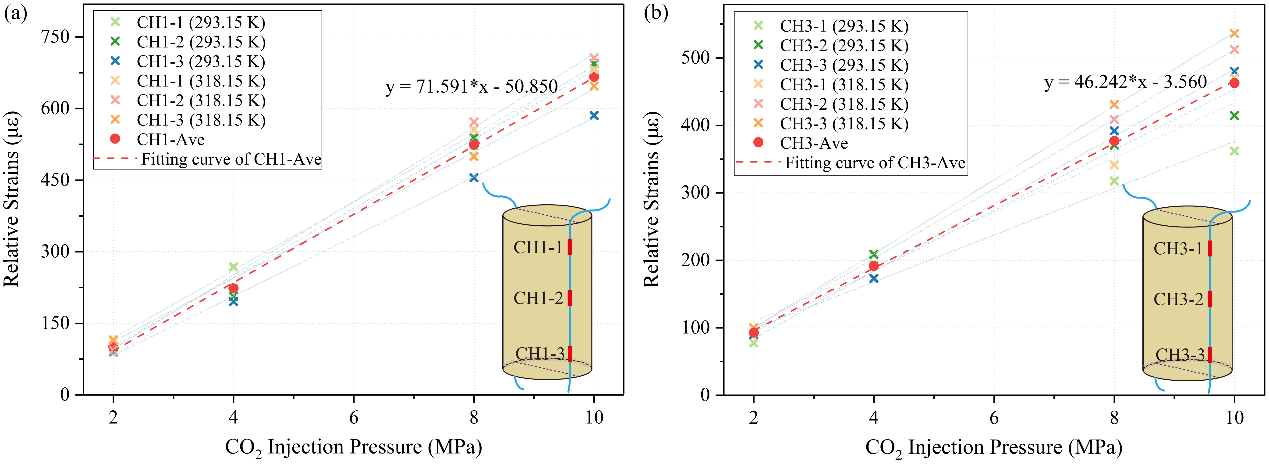[ China Instrument Network Instrument Development ] Global warming has become an increasingly important environmental issue of concern. In order to reduce the carbon content of the atmosphere and control the impact of the greenhouse effect on the global climate, carbon dioxide (CO2) geological storage technology is gradually recognized as a safe and effective way to deal with the above climate problems. The deep underground saline layer as the main storage carrier is considered to be the best site for CO2 long-term storage because of its wide distribution and large storage capacity. However, due to changes in reservoir stress field and the existence of natural fractures, faults and other geological structures and structures, there may be a risk of leakage during CO2 storage. Therefore, it is necessary to monitor the CO2 migration process including the migration path and the leading edge in real time.

Fig.1 Surface affixing two FBG sensors (a) CH1 and (b)CH3 to monitor the relative strain response of the core surface induced by CO2 injection under different temperature and pressure conditions
Fig. 2 The fiber Bragg grating sensor CH1 monitors the initial strain response time difference of the three gratings on the core surface under a constant effective confining pressure of 8 MPa. (a)~(b) Grating strain response and time difference after gaseous CO2 injection; (c)~(d) grating strain response and time difference after liquid CO2 injection; (e)~(f) grating strain response after supercritical CO2 injection Time difference.
At present, domestic and foreign laboratories have conducted in-depth research on CO2 indoor core displacement experiments, mainly focusing on CO2 dissolution capture mechanism and monitoring of migration process, but lack of real-time migration of supercritical carbon dioxide (scCO2) under storage conditions. The stress field changes during the process and the simultaneous monitoring of the migration front. For the first time, the Wuhan Institute of Rock and Soil Mechanics of the Chinese Academy of Sciences uses fiber Bragg grating (FBG) sensing technology to monitor the displacement process of CO2 in different states in real time, revealing the mechanism of stress field change and the migration front under the induction of CO2 injection pressure. law.
The core-displacement gripper used by the researchers meets the experimental requirements at 50 MPa and 60 °C, while achieving stable displacement of scCO2 (31.1 ° C, 7.38 MPa). Two FBG sensors are used, which are embedded in three single-wavelength continuous gratings and symmetrical on the surface of the rock along the axial direction of the core. The experimental sample is the red sandstone of the Penglai Town Formation in the Jurassic in the Sichuan Basin. The experimental results show that the dynamic strain response of the core surface is related to the CO2 injection pressure and maintains a linear growth relationship (Fig. 1). Based on this, the stress field variation induced under the condition of higher injection pressure can be further predicted and the experimental data and theoretical basis for reservoir and wellbore stability evaluation can be provided. In addition, it can be seen from the experimental results that the strain response at 45 °C is slightly higher than 20 °C, which is due to the fact that the grating is sensitive to temperature changes and the core is subject to thermal expansion and deformation. Since the three gratings are arranged axially on the upper, middle and lower positions of the rock sample, the fluctuation of the internal stress field of the induced core after CO2 injection will be transmitted to the sensing regions of the three gratings to generate the corresponding strain response and initiality. Response time difference (Figure 2). The initial strain time difference is different under different temperature and pressure conditions. It can be seen from Fig. 2 that when the injection pressure is 2 MPa and the confining pressure is 10 MPa, the maximum time difference is 0.5 s; and at 20 ° C, the pore pressure is increased to 8 MPa and the confining pressure is maintained at 16 MPa, the initial response time difference has been increased to 1.3 s. This is mainly because the change of the injection pressure causes the CO2 to change from the gaseous state (gCO2) to the liquid state (lqCO2), and when the lqCO2 is warmed to maintain the supercritical state, the initial time difference is slightly reduced. The change in temperature and pressure has a significant effect on the properties of CO2, especially the dynamic viscosity coefficient of the fluid. According to the ratio of time difference and grating center interval, the migration velocity of CO2 in different states can be preliminarily estimated: gCO2 has the fastest migration speed; lqCO2 is the slowest; scCO2 is between the two. Therefore, according to the FBG measurement results, this monitoring technology can be used to observe the CO2 fluid migration path and the corresponding leading edge information, which is helpful for the application of leakage monitoring at the CO2 storage site. Finally, the COMML software was used to simulate the above experimental process. The simulation results were highly consistent with the experimental results, which further verified the authenticity of the experimental data and the effectiveness of the monitoring technology.
The research results were published in the magazine "Greenhouse Gases: Science and Technology" by Wiley Publishing. The first author is Fan Chengkai, a graduate student at Wuhan Institute of Geotechnical Engineering, and the researcher is Li Qi. The results were jointly funded by the National Natural Science Foundation of China (No. 41274111) and the Sino-Australian Carbon Dioxide Geological Storage (CAGS3) project.
(Original title: Wuhan Geotechnical Institute based on fiber optic sensing monitoring supercritical carbon dioxide migration leading edge research progress)




